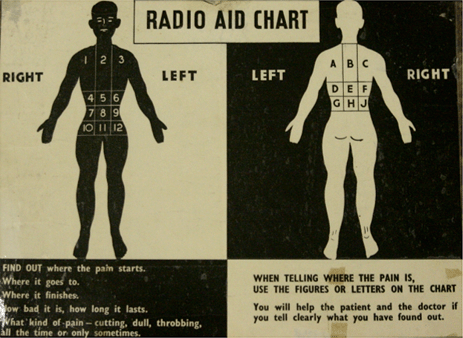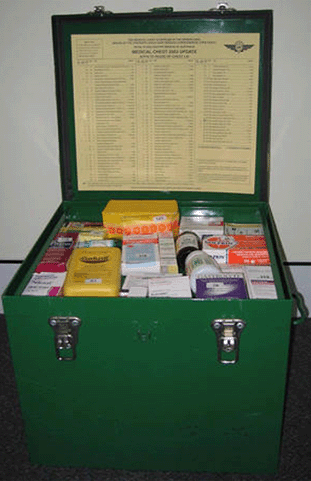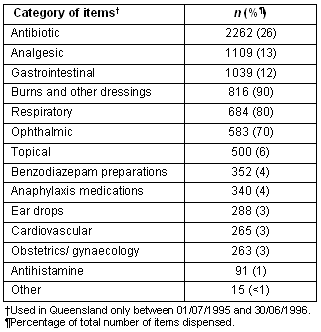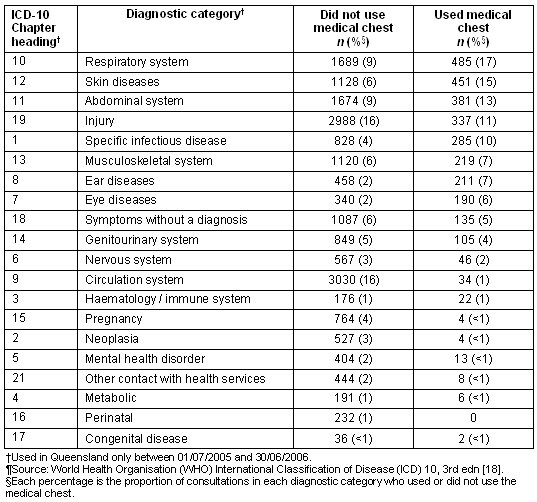Introduction
Since the late 1990s there has been progressive recognition of rural and remote medicine as a specific field of practice. In Australia this has culminated in the accreditation of specific training pathways for medical practitioners, through both the Australian College of Rural and Remote Medicine1 and the Royal Australian College of General Practitioners2. More recently remote medical practice has been developed into a unique discipline in its own right with telehealth as one of the eight defining key features of remote medical practice3. The definition of telehealth/ telemedicine is usually confined to a consideration of consultations alone4-6 but can extend to include other aspects of health care, including the ordering and delivery of medications, otherwise known as tele-pharmacy7. The aim of this article is to describe the tele-pharmacy program of the Royal Flying Doctor Service in Australia that has been in continuous operation for over 65 years. This will help address the distinct paucity of information in the literature about tele-pharmacy, and also provide a detailed description that may benefit other countries that share similar remoteness issues in healthcare provision. Approval for this study was granted by the Human Research Ethics Committees of both James Cook University and the University of Queensland.
Remote Australia is almost 6 million km2, covering over three-quarters of the Australian continent, yet it is inhabited by only 4% of the population of over 20 million people. This diverse landscape is characterised by geographic isolation, cultural diversity, socio-economic inequality, resource inequity, Indigenous health inequality and a full range of extreme climatic conditions8. Those living and working in remote Australia include Indigenous Australians, generational station farming families, transient mine workers, short- and long-term professional people, industry employed people, seasonal and tourism workers. Additionally, those who work on ships, oil rigs and offshore islands and territories are considered to come under the jurisdiction of remote Australia9. Few healthcare services exist in remote Australia, with the distance to the nearest facility often measured in hundreds of kilometres, and travel times in multiple hours. Emergency transport for more remote locations is typically limited to fixed-wing, long-distance aircraft10.
The Royal Flying Doctor Service
Founded in 1928 in remote western Queensland to overcome the 'tyranny of distance' the Royal Flying Doctor Service (RFDS) is the longest running telehealth provider and aeromedical retrieval service in the world, and the largest fixed-wing operation of its kind10. The RFDS provides an extensive range of face-to-face and distance-based health services to those living in remote Australia. Face-to-face services include aeromedical retrieval, interhospital transfer, as well as medical, nursing and allied health clinics in remote communities. A summary timeline of key RFDS events is detailed (Table 1).
Table 1: Summary timeline of key events

The Royal Flying Doctor telehealth consultation services
Telehealth consultations across remote Australia have been provided by the RFDS since 1929 when the Traeger Pedal Wireless was introduced. Consultations were initially conducted in Morse code, moving to voice radio in the mid-1930s. Difficulty in reception and accurately hearing detailed message content resulted in ambiguity in describing the location of pain and other symptoms and signs. In 1951 a simple device to address this issue was developed by Sister Lucy Garlick, the flying nurse working from the Wyndham base in Western Australia: the 'Where Does It Hurt Chart' (Fig 1)11.

Figure 1: The 'Where does it Hurt?' chart introduced in 1951.
The widespread roll out of fixed-line telephone services to remote Australia in the 1980s, followed by satellite telephone services in the mid-1990s and mobile telephone services in remote towns by the turn of the century, have consolidated the integrity of the communication system between doctor and patient. Modern communications means the doctor remains accessible regardless of location: home, office, travelling, aircraft, during aeromedical retrieval and at remote locations. Similarly, patients can speak direct to the doctor whether they are at the homestead or some distance away. Another notable benefit is that consultations are no longer held through a publicly accessible radio band but through private point-to-point telephone services. The radio telephone service remains in place for emergencies but in recent years it has rarely been used. Distance-based services are centred on the 24/7 telehealth consultation with a doctor service for those living in remote Australia.
Telehealth: logistics Australia wide
During the 12 months 1 July 2005 to 30 June 2006, the RFDS provided 77 135 telehealth consultations across Australia, an average of 211 per day16. Of these, 99.8% were by standard telephone fixed or mobile line, 92 were by videoconference and only 5 by radiophone. Notably the number of RFDS telehealth consultations across Australia 10 years earlier in the 12 months 1 July 1995 to 30 June 1996 was approximately half at 36 440.
Royal Flying Doctor tele-pharmacy services
Development
In 1939 Dr Keith Sweetman, the flying doctor working from the Wyndham base in Western Australia, identified that telehealth was of limited value in the absence of pre-positioned medications for the patient to access12. He also realised that considerable radio time was being wasted by questioning the outposts as to what was available in their first aid kits. The majority had haphazard collections of patient medicines, 'a first aid set augmented by this and that'13. He suggested standardising the medical equipment held in remote locations so that people at those locations could self-administer treatment under the instruction of the doctor through radio consultations11. This was subsequently adopted by the RFDS Federal Council in 1942 after an inquiry conducted by Dr Simpson and Dr Vickers, including that each item be numbered to avoid confusion12. Prior to the advent of a reliable telephone service the high-frequency radio phone often distorted sound, making it difficult to hear exactly what was said. The advent of a numbered system of medications facilitated accuracy in the face of difficult communication systems.
The purchase price for each of the initial 52 medical chests was ₤12, compared with the 2007 price of $AU378 for the metal chest and more than $AU800 for the medications11. The design and build of the medical chest as a grey enameled robust steel box with a lockable lid remains essentially unchanged since inception, and now includes five closely packed trays containing more than 86 items (Fig2)14. The importance of the RFDS medical chest in Australian history is confirmed by the fact that an example of the chest manufactured in 1987 is on display in the Powerhouse Museum in Sydney, NSW15.

Figure 2: A photograph of a medical chest in current use.
Medical chest content
The RFDS medical chest has evolved over many years to cover a number of medical conditions, not just emergencies, which it would be difficult for people living and working in remote areas to otherwise treat. Apart from pharmaceuticals, the chest contains a variety of equipment including bandages and dressings of various types and sizes, hypodermic syringes and needles, a scalpel, dressing scissors, a kidney dish, urinary catheter, first aid manual and a video on how to give intramuscular injections. There are a large number of 'prescription only' pharmaceutical items that (as a condition of the provision of the chest) can only be dispensed on the advice of a registered RFDS medical practitioner. The use of a simple numbering system ensures that correct medications are dispensed independent of changes in brand and packaging over time.
Government regulation of the Medical Chest Program
Funding and government regulation are important considerations in tele-pharmacy. Under normal circumstances, the dispensing of medications is the province of pharmacists, with the cost to the consumer at times subsidised through government or private insurance schemes. For those living in remote areas where few pharmacists reside, this inevitably means travelling to a distant larger town to visit a pharmacy in person or using a mail order service. Although this may be suitable for stable chronic disease, it is unsatisfactory in the event of acute or unexpected illness. In recognition of this, government regulations in Australia specifically allow remote dispensing of the medications held in the medical chest without the services of a pharmacist. Funding is directly addressed by government sponsorship of the medical chest program, and medications are provided free of charge to the consumer on the condition the chest is assigned to a person living and working in the same location for greater than 6 months, and which is greater than 80 km from the nearest health service. Additionally, private companies such as mining and exploration, and coastal shipping may obtain the chest at cost. Each chest is registered to a specific location with the responsibility for maintaining and dispensing resting with the registered chest holder. This responsibility includes ensuring that used and expired medications are replaced in a timely fashion. In 2006 there were over 3500 medical chests throughout Australia, including 1330 in Queensland.
Processes: Medications are dispensed by the registered medical chest holder and are at no cost to the recipient. A written record is kept by the chest holder, which includes the item/s dispensed, recipient details and the name of the RFDS authorising doctor (the only person who has the authority to dispense from the medical chest). The prescribing doctor holds similar details in the medical record for each telehealth consultation. From a privacy perspective, this means that the registered chest holder will be aware of what individuals in their community are being dispensed, but he/she is not privy to other aspects of the consultation, including diagnosis. The use of names and numbers for each item provides a mechanism to double check dispensing accuracy. The chest is re-supplied after the medications have been dispensed or have passed their expiry date. These processes are initiated by the registered chest holder whose responsibility it is to ensure the chest has a full complement of in-date supplies. The re-supply process is free for those with a subsidised chest and paid for by the chest holder for non-subsidised chests.
Each telehealth consultation is conducted with the understanding that the duty of care provided by the doctor is identical to that expected in a face-to-face consultation. The doctor attempts to elicit as much information as possible to establish a diagnosis and ensure safe management, at times a process requiring repeat telehealth consultations. There have not been any medico-legal actions initiated from consequences of the medical chest program.
Tele-pharmacy in Queensland
In the absence of comprehensive Australia-wide statistics, detailed service provision for the state of Queensland is provided here. In the 12 months 1 July 2005 to 30 June 2006, RFDS staff in Queensland provided 21 470 telehealth consultations. The male : female ratio of patients was 56:44, the average age of patients was 39.9 ± 24.7 years (range: newborn to 97 years), and 3861 (25.0%) consultations concerned Indigenous people.
Dispensing: Medical chest items were prescribed in 2938 (13.7%) consultations, with dispensing from other sources (eg healthcare clinic stock or personal supply) in 1547 consultations (7.2%), resulting in 8607 items being dispensed. This is a much lower rate of prescribing than the 64% of consultation encounters that resulted in at least one medication being prescribed as found in the study of General Practice Activity in Australia 2006-200717. Categories of items prescribed from the medical chest are detailed (Table 2). Antibiotics, analgesics and medications for abdominal complaints were the three most common categories of medication supply, accounting for half of all dispensed items. In the study of General Practice Activity in Australia 2006-2007, the proportion of prescribed medications in each of these categories was 19% for antibiotics, 10% for analgesics and 9% for medications for abdominal complaints17. However, due to the large number of medications supplied, even medications in uncommon categories such as cardiovascular were still dispensed over 250 times. This suggests that the medical chest caters for a broad range of needs, not just common events.
Table 2: Items dispensed from the medical chest by category

Diagnosis: The diagnostic categories for those consultations where medical chest medications were dispensed are detailed (Table 3). These were classified according to the WHO International Classification of Disease (ICD) 1018. Medical chest items were most commonly dispensed for the clinical diagnoses of respiratory, skin and abdominal problems and these accounted for almost half of all diagnoses. Conversely, these diagnostic categories accounted for approximately one-quarter of all consultations where a medical chest item was not dispensed. Again, this suggests the medical chest caters for a broad range of needs, not just common events.
Table 3: Primary diagnostic categories of telehealth consultations according to use of medications

Discussion
Telehealth is a core feature of the distinct discipline of remote health. For those receiving their care by telehealth consultation, tele-pharmacy provides the timeliest option for receiving prescribed medications, a method that has to date received little consideration in the literature19. This report provides a detailed examination of one of the few programs across the globe that addresses dispensing medications in a timely fashion to those residing in remote areas, using telehealth consultation services. Of note, this model has also been successfully applied in the Falkland Islands20.
Each year increasing numbers of older people with established chronic diseases regularly travel to and visit remote parts of Australia, where they often rely on remote health services to dispense medications21. This is similar to the isolated environment of cruise ships, where passengers rely on ship-based medical services for medications22. Although medications are generally brought from home in sufficient quantities to cover the period in remote areas, there is still a need for medications to cover unexpected illness and emergencies. These situations are addressed by the RFDS medical chest.
The RFDS Medical Chest Program operates without the direct input of a dispensing pharmacist, with the medical practitioner taking responsibility for both prescribing and dispensing the medication. A novel US program described by Clifton et al. incorporated remote dispensing with telehealth consultations with the dispensing pharmacist23. In the US program, patients in remote locations were able to access their medications in a timely fashion with the additional benefit of pharmacy services. However, this program required both data- and vide-oconference links between the patient and the pharmacy. The advantage of the RFDS program, which requires only a phone line, is that it can operate in isolated locations where there is minimal IT infrastructure, such as remote homesteads, mines and ships at sea, as well as during adverse weather when satellite-based IT systems often fail. These are important considerations, especially where a retrieval response may take considerable time to arrive.
The contents of the RFDS medical chest has evolved over more than 50 years to ensure a supply of appropriate medications. By way of comparison, a 2005 review of telemedical consultations for ships by Radio Medical Denmark found that the contents of the medicine chest available on ships was often insufficient and limited to analgesics in the absence of many lifesaving medications, even though a broad range of clinical problems presented, including 18% being life-threatening conditions24.
The study detailed in this article found a relatively low rate of prescribing when compared with the rest of the general practice population. This is most likely due to the nature of the service, where consultations tend to be focussed on the presenting complaint and are not intended to replace the more comprehensive nature of general practice consultations, where a broad range of issues may be considered within each consultation, especially in the context of chronic disease management. This issue is compounded by the nature of rural patients, who tend to have a later presentation and diagnosis than their urban counterparts25. Another issue to consider is that medications in the RFDS medical chests are focussed on acute care issues, leaving ongoing medications for chronic disease to be sourced from other consultations.
Limitations
The RFDS database for diagnosis utilises the ICD-10 coding system18, while the database for medications is based on an internal RFDS historical categorisation which began in the 1940s. Unfortunately this makes comparison with normative data about Australian general practice through the BEACH study17 problematic, because the latter is based on the ICPC-2 classification system, which cannot be accurately matched with ICD-10. Similarly, the classification of medications differ and are not directly comparable.
Although this case study does not provide any definitive data on cost-effectiveness, the RFDS Medical Chest Program does provide an opportunity for definitive treatment to be delivered remotely in a timely fashion without the need for mail order pharmacy or significant patient travel, both at considerable time and dollar cost, similar to the Alaskan experience documented by Hudson7.
Conclusion
Telehealth, a key component of remote health care embraces both consultation and provision of other services, including tele-pharmacy. The RFDS Medical Chest Program is a successful large-scale provider of medications to those living in remote Australia, enabling early access to medications for both emergencies and definitive care, while minimising the need for mail-order pharmacy or patient travel. This model of care provides an important template for those designing service delivery models in other remote locations. A more comprehensive analysis of the outcomes of this service is recommended. This may be accomplished by undertaking a prospective study which includes a comparison with face-to face consultation in rural and remote practice.
Acknowledgement
The authors wish to acknowledge the support given to prepare this manuscript provided by the Royal Flying Doctor Service (Queensland Section).
References
1. Smith JD, Prideaux D, Wolfe CL, Wilkinson TJ, Sen Gupta T, DeWitt DE et al. Developing the accredited postgraduate assessment program for Fellowship of the Australian College of Rural and Remote Medicine. Rural Remote Health 7: 805. (Online) 2007. Available: www.rrh.org.au (Accessed 12 May 2008).
2. Royal Australian College of General Practitioners. Education and training: Fellowship in Advanced Rural General Practice/Graduate Diploma in Rural General Practice. (Online) 2008. Available: http://www.racgp.org.au/fargp (Accessed 1 March 2008).
3. Dade-Smith J, Margolis SA, Ayton J, Ross V, Chalmers E, Giddings P et al. Defining remote medical practice: results from a consensus meeting of medical practitioners working and teaching in remote medical practice. Medical Journal of Australia 2008; 188: 159-161.
4. Whitten P, Johannessen LK, Soerensen T, Gammon D, Mackert M. A systematic review of research methodology in telemedicine studies. Journal of Telemedicine and Telecare 2007; 13(5): 230-235.
5. Stanberry B. Telemedicine: barriers and opportunities in the 21st century. Journal of Internal Medicine 2000; 247(6): 615-628.
6. Tulu B, Chatterjee S, Maheshwari M. Telemedicine taxonomy: a classification tool. Telemedicine Journal of E Health 2007; 13(3): 349-358.
7. Hudson HE. Rural telemedicine: lessons from Alaska for developing regions. Telemedicine Journal of E Health 2005; 11(4): 460-467.
8. Strong K, Trickett P, Titulaer I, Bhatia K. Health in rural and remote Australia: The first report of the Australian Institute of Health and Welfare on rural health. Canberra, ACT: Australian Institute of Health and Welfare, 1998.
9. Smith J D. Australia's rural and remote health: a social justice perspective, 2nd edn. Melbourne, VIC: Tertiary Press, 2007.
10. Margolis SA, Ypinazar VA, Muller R. The impact of supply reduction through alcohol management plans on serious injury in remote indigenous communities in remote Australia: a ten-year analysis using data from the royal flying doctor service. Alcohol Alcoholism 2008; 43(1): 104-110.
11. Persson S. The Royal Flying Doctor Service of Australia. Wollombi, NSW: Exisle Publishing, 2007.
12. Page M. The Flying Doctor story 1928-1978. Adelaide, SA: Rigby, 1977.
13. Royal Flying Doctor Service. Medical Chests. (Online) 2008. Available: http://www.flyingdoctor.net/content.aspx?PageID=257 (Accessed 15 May 2008).
14. Bilton J. The Royal Flying Doctor Service of Australia. Sydney, NSW: Halstead, 1962.
15. Powerhouse Museum. Object: 2000/36/1 Medical chest, containing medications/ dressings/ medical instruments and instruction sheets, metal / mixed materials, various manufacturers, Royal Flying Doctor Service of Australia, 1987. (Online) 0000. Available: http://www.powerhousemuseum.com/collection/database/?irn=8810 (Accessed 1 October 2007).
16. Royal Flying Doctor Service (Qld). Operational statistics: 2005-2006 Financial Year. (Online) 0000. Available: http://www.flyingdoctor.org.au/Content/Attachment/Stats.pdf (Accessed 1 October 2007).
17. Britt H, Miller G, Charles J, Bayram C, Pan Y, Henderson J et al. General practice activity in Australia 2006-2007. Canberra, ACT: Australian Institute of Health and Welfare, 2008.
18. World Health Organization. International Statistical Classification of Diseases and Related Health Problems, 10th rev, 3rd edn. (Online) 2003. Available:
http://www.who.int/classifications/apps/icd/icd10online2003/fr-icd.htm (Accessed 1 September 2006).
19. Koch S. Home telehealth - current state and future trends. International Journal of Medical Information 2006; 75(8): 565-576.
20. Diggle R. Medicine in the Falkland Islands. Postgraduate Medical Journal 2003; 79(927): 3-4.
21. Tate J, Mein J, Freeman H, Maguire G. Grey nomads - health and health preparation of older travellers in remote Australia. Australian Family Physician 2006; 35(1-2): 70-72.
22. Brewer PA, Barry M. Survey of web-based health care information for prospective cruise line passengers. Journal of Travel Medicine 2002; 9(4): 194-197.
23. Clifton GD, Byer H, Heaton K, Haberman DJ, Gill H. Provision of pharmacy services to underserved populations via remote dispensing and two-way videoconferencing. American Journal of Health-System Pharmacy 2003; 60(24): 2577-2582.
24. Jensen OC, Bo Boggild N, Kristensen S. Telemedical advice to long-distance passenger ferries. Journal of Travel Medicine 2005; 12(5): 254-260.
25. Howat A, Veitch C, Cairns W. A descriptive study comparing health attitudes of urban and rural oncology patients. Rural Remote Health 6: 563. (Online) 2006. Available: http://www.rrh.org.au/ (Accessed 12 May 2008).
Abstract
In recent times remote medical practice has been developed into a unique discipline in its own right with telehealth one of the eight defining key features. Since 1942, the telemedicine consultation service provided by the Royal Flying Doctor Service in Australia has been supported by a tele-pharmacy program known as the Medical Chest Program. The contents of the chest comprise more than 85 items, including medications and equipment which can be prescribed during a telehealth consultation to cover both emergency care and definitive treatment for less serious conditions. By 2006 there were 3500 medical chests placed throughout Australia. Specifically, the state of Queensland had 21 470 telehealth consultations from 1 July 2005 to 30 June 2006, resulting in the prescription of at least one medical chest item in 2938 (13.7%) consultations. Queensland data regarding medication indicate that antibiotics (26%), analgesics (23%) and gastrointestinal medications (12%) were the most common categories of dispensed medications, and that the most common clinical diagnostic categories for the consultation resulting in dispensed medications were respiratory (17%), skin (15%) and abdominal conditions (13%). In summary, the RFDS medical chest program continues to be a successful large scale provider of medications to those living in remote Australia, enabling early access to medications for both emergencies and definitive care, while minimising the need for mail-order pharmacy or patient travel. This model of care may provide an important template for those designing service delivery models in other remote jurisdictions.
Key words: Australia, remote medicine, tele-pharmacy, telehealth, telemedicine.
You might also be interested in:
2022 - Experiences of rural and remote nurses during and following disasters: a scoping review
2022 - Developing supervision capacity for training rural generalist doctors in small towns in Victoria

